If you’re reading this article, then you’ve probably heard about the food in Puebla. Like Mexico City and Oaxaca, Puebla City is home to some of the most delicious food in Mexico.
And we aren’t just talking about typical Mexican food like tacos and quesadillas either. When you visit Puebla, you’ll get to try interesting dishes like chanclas, camotes, and pipián. Mole poblano and chiles en nogada are signature dishes and probably unlike anything you’ve ever tasted before.
If you’ve been to Mexico City and love tacos al pastor, then you’ll be interested to learn that Puebla is home to the crossover dish that inspired it. Like Oaxaca, Puebla is rich in culinary traditions and is a must-visit for any Traveleater.
Mole poblano is the most important but be sure to look for all twelve of these dishes the next time you visit Puebla.
POBLANO CUISINE QUICK LINKS
To help you with your Puebla trip planning, we’ve put together links to recommended hotels, tours, and other travel-related services here.
HOTELS
Top-rated hotels in Centro Historico, one of the best areas to stay for first-time visitors to Puebla City.
- Luxury: Banyan Tree Puebla
- Midrange: Hotel Boutique Casareyna
- Budget: Hostal Casa De Arcos
TOURS
- Sightseeing Tour: Half-Day Private City Tour with Transportation
- Food Tour: Guided Foodies Tour with Cathedral Visit
- Cooking Classes: Puebla Cooking Classes
- Day Trip: Cholula Magical Town 6-Hour Tour by Double-Decker Bus
OTHER SERVICES
Save This on Pinterest!
No time to read this guide on the food in Puebla? Click on the save button and pin it for later!
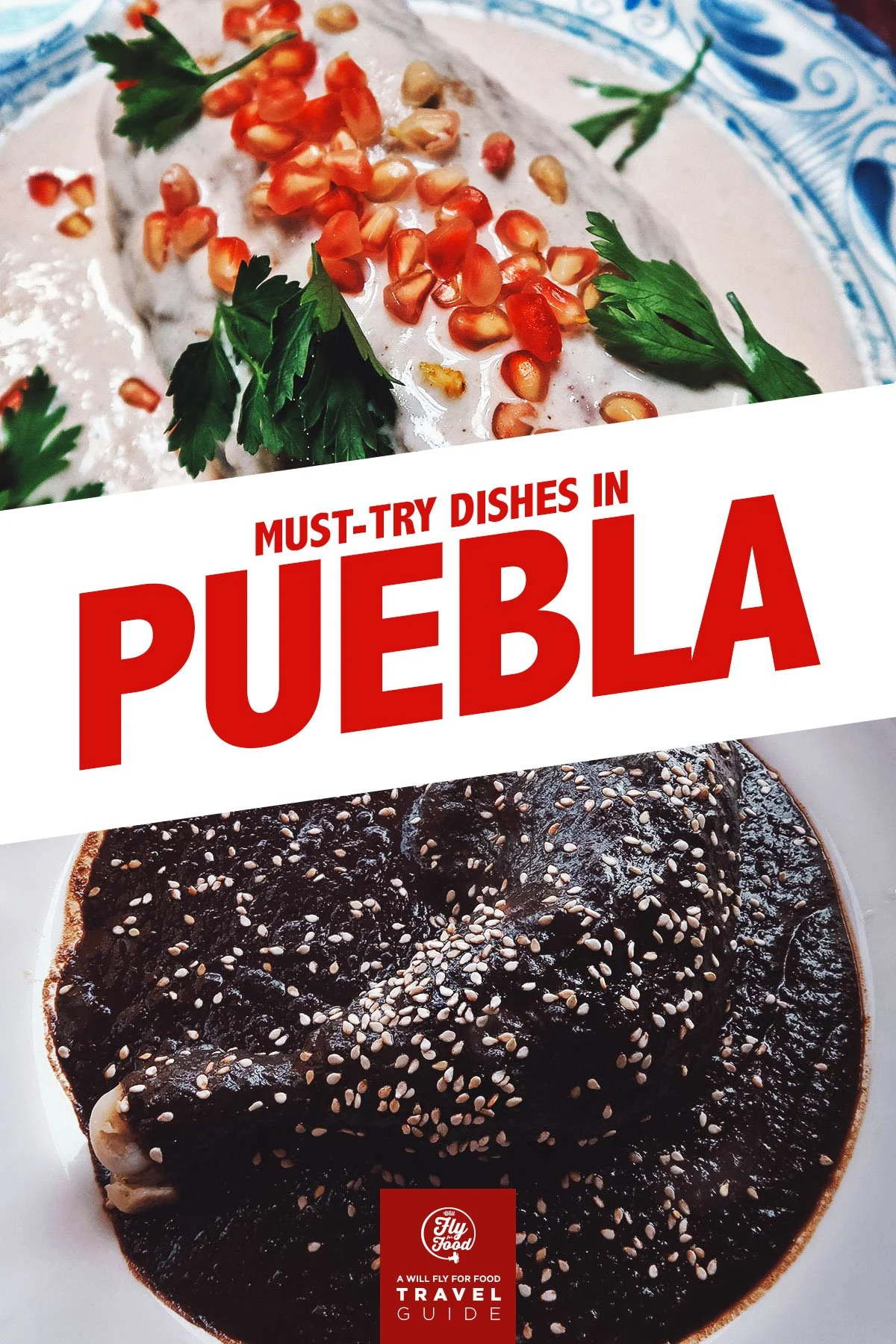
WHAT FOOD IS PUEBLA, MEXICO FAMOUS FOR?
Puebla is home to many delicious dishes, but if you only had one day in the capital city, then you have to go for mole poblano. It’s a national dish and something that you cannot miss. If you visit in August or September, then chile en nogada is a must as well.
After you’ve familiarized yourself with what to eat in Puebla, then be sure to check out our article on the best restaurants in Puebla to learn where you should go to try these dishes.
1. Mole Poblano
Mole is a defining dish in Mexican cuisine. When people think of mole, they usually think of mole poblano. It’s the signature dish of Puebla and regarded by many as Mexico’s national dish.
Mole poblano is a thick sauce made with about twenty different ingredients, among the most important being cocoa and chili peppers. Chocolate is often used as a shortcut but moles made from scratch are typically made with cocoa and sugar. Dark brown in color and intensely rich in flavor, it’s traditionally served over turkey with sesame seeds and a side of rice.
There are two legends that recount the origin of mole poblano. The first and more popular claims that the dish was created in the 16th century by nuns from the Santa Rosa Convent. The archbishop was paying them a visit and they had nothing to prepare for him except for an old turkey.
They mixed together whatever ingredients they had in the kitchen like different types of chili peppers, old bread, chocolate, and spices. They cooked the sauce for hours and poured it over the turkey meat. Thankfully, the archbishop enjoyed the dish and the rest is history.
Mole poblano is best when made from scratch but according to a local we met in Oaxaca, most moles at restaurants are made with mole paste. A proper version takes about three days to prepare. If restaurant moles are already this good, then I can only imagine what proper moles must taste like!
Mole poblano truly is a labor of love. It’s considered the pinnacle of Mexican culinary traditions and best enjoyed during the Cinco de Mayo celebrations. It’s featured prominently in this annual festival that commemorates Mexico’s victory over France in the Battle of Puebla in 1862.
If you’d like to make this delicious dish yourself, then be sure to check out our authentic mole poblano recipe. It was developed by a local chef who runs a popular cooking class in Puebla.
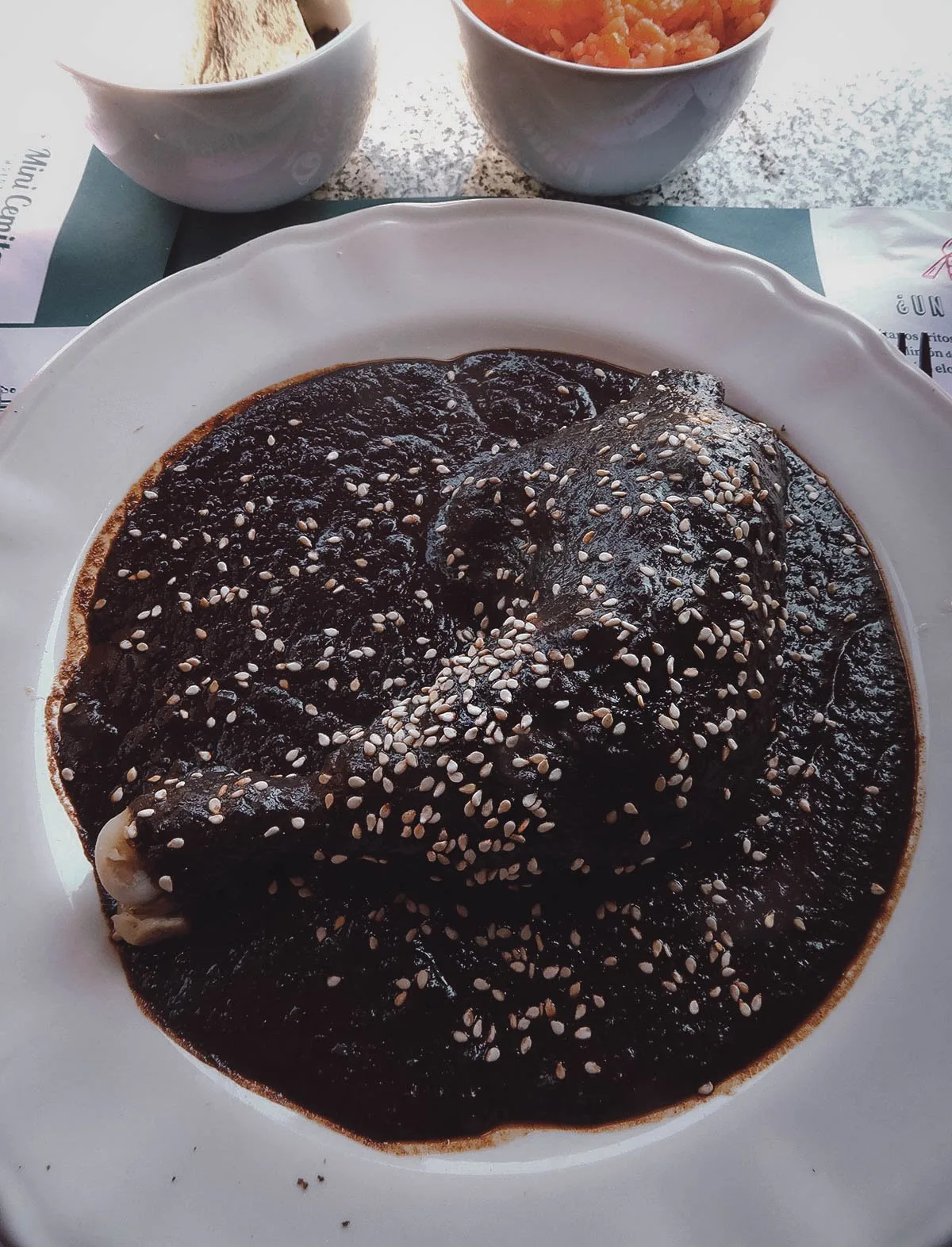
2. Pipian Verde
I’m not sure if it qualifies as a type of mole, but pipián refers to any Mexican sauce made with pepitas (pumpkin seeds) as its main ingredient. In Puebla, pipián verde seems to be the most common though you can also find a red version known as pipián rojo.
Recipes vary but pipián verde or “green mole” is typically made with ground toasted pumpkin seeds mixed with pureed greens, tomatillos, and green chili peppers (poblano, serrano, jalapeño). Other ingredients include sesame seeds, peanuts, garlic, and spices.
3. Pipian Rojo
Pipián rojo is similar to pipián verde except its made with red chili peppers and tomatoes.
Pictured below is a mole degustation platter with four different types of sauces – pipián verde, pipián rojo, poblano, and blanco. Mole blanco is a type of Oaxacan mole made with roasted and ground peanuts, almonds, pine nuts, sunflower seeds, and white corn tortillas mixed with fruits, white chocolate, milk, chili peppers, and spices.
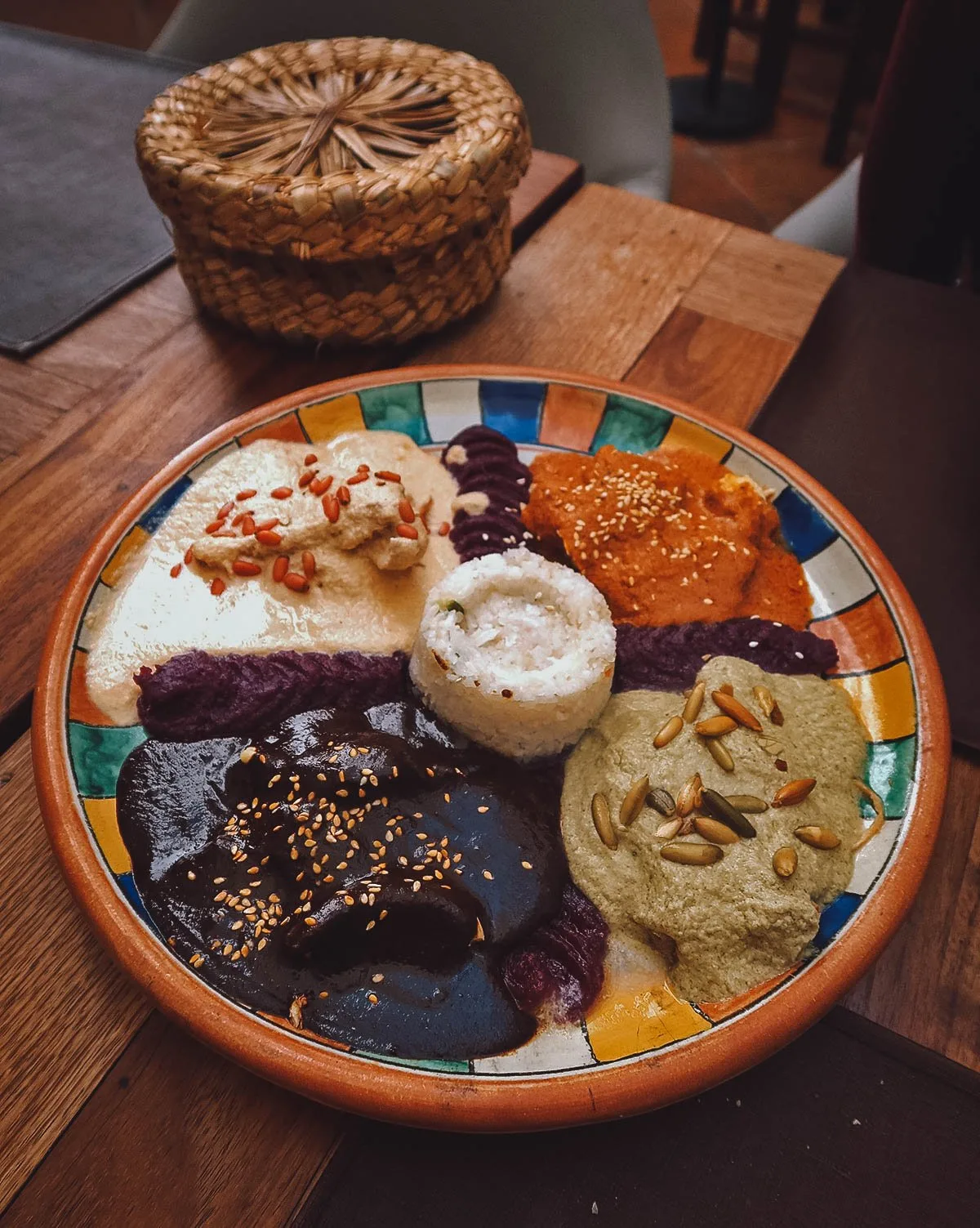
4. Chiles en Nogada
Like mole, chile en nogada is considered a signature dish of Puebla and Mexico’s national dish. It’s a visually striking dish consisting of a large poblano chili stuffed with a picadillo mixture containing ground meat, panochera apple, sweet-milk pear, criollo peach, aromatics, and spices.
The stuffed pepper is then drowned in a creamy white sauce made with walnuts, milk, double cream, fresh cheese, and sherry, before being garnished with red pomegranate seeds and parsley. Both the poblano chili and walnut sauce are typically served at room temperature.
Unlike mole that’s available year-round, chile en nogada is a seasonal dish that’s traditionally enjoyed when pomegranates are in season, usually from around August till mid-September. Tied to Mexican Independence Day, it’s a patriotic dish whose coloration represents the main colors of the Mexican flag – chile poblano for green, walnut sauce for white, and pomegranate seeds for red.
Chiles en nogada are largely unavailable at other times of the year but if you visit Puebla in August or September, then you cannot leave the city without trying this dish.
If you’d like to make this beautiful dish at home, then you’ll definitely want to check out our authentic recipe for chiles en nogada. It was developed by the same chef who created the mole poblano recipe.
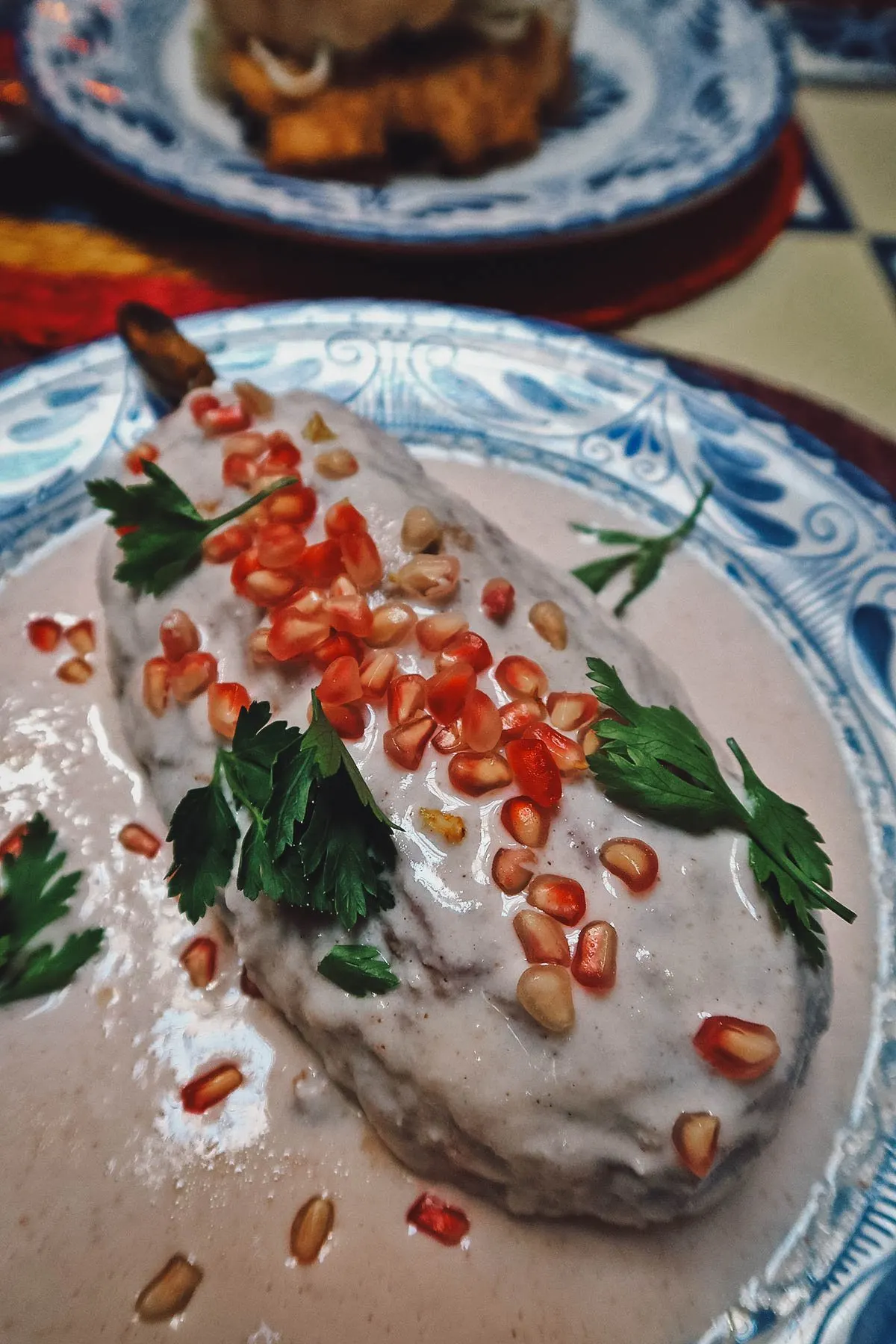
5. Tacos Arabes
If you like the iconic taco al pastor, then you need to try tacos arabes as well. It’s considered the predecessor of tacos al pastor and is the first Mexican iteration of the Lebanese shawarma.
Sometime after the First World War, a wave of Lebanese immigrants settled in Puebla and brought with them their shawarma-making tradition. Over time, locals tweaked the recipe to suit the Mexican palate. They substituted lamb with pork and created what would eventually become known as tacos arabes.
Tacos arabes are similar to tacos al pastor except they’re flavored with Middle Eastern spices and indigenous central Mexican ingredients. Another important difference is that the grilled pork is wrapped in pan arabe (pita bread) instead of corn tortillas and it isn’t served with any pineapple.
Pictured below is a version made with jocoque, a Mexican fermented milk product similar to sour cream.
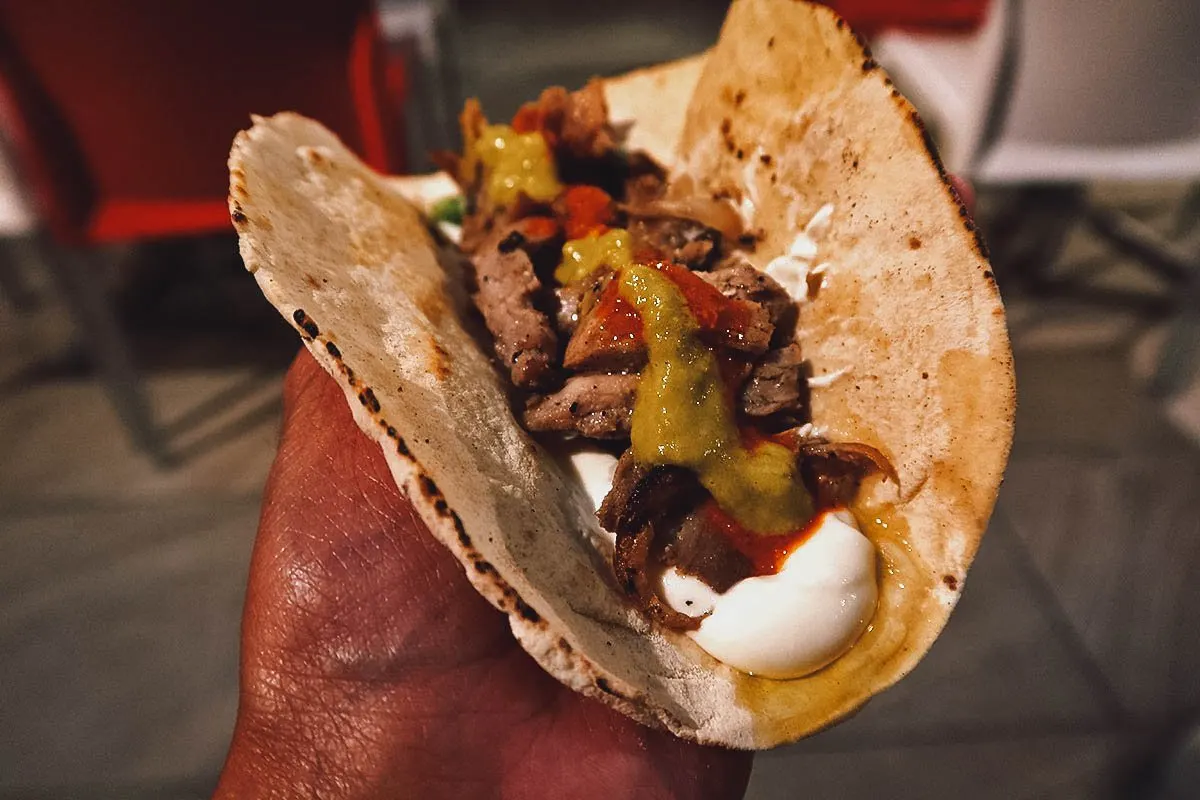
This picture of spit-roasted pork helps illustrate the difference between tacos arabes and tacos al pastor.
The spit on the far left is for tacos al pastor. It’s much more orange in color due to the use of annatto (achiote) seeds in the marinade. It’s also shaped like a top – hence the term trompo (spinning top) – unlike the arabe spits that are more cylindrical in shape.
Don’t mind the size difference in this picture. Al pastor trompos are usually much bigger, about the same size as the arabe spits.
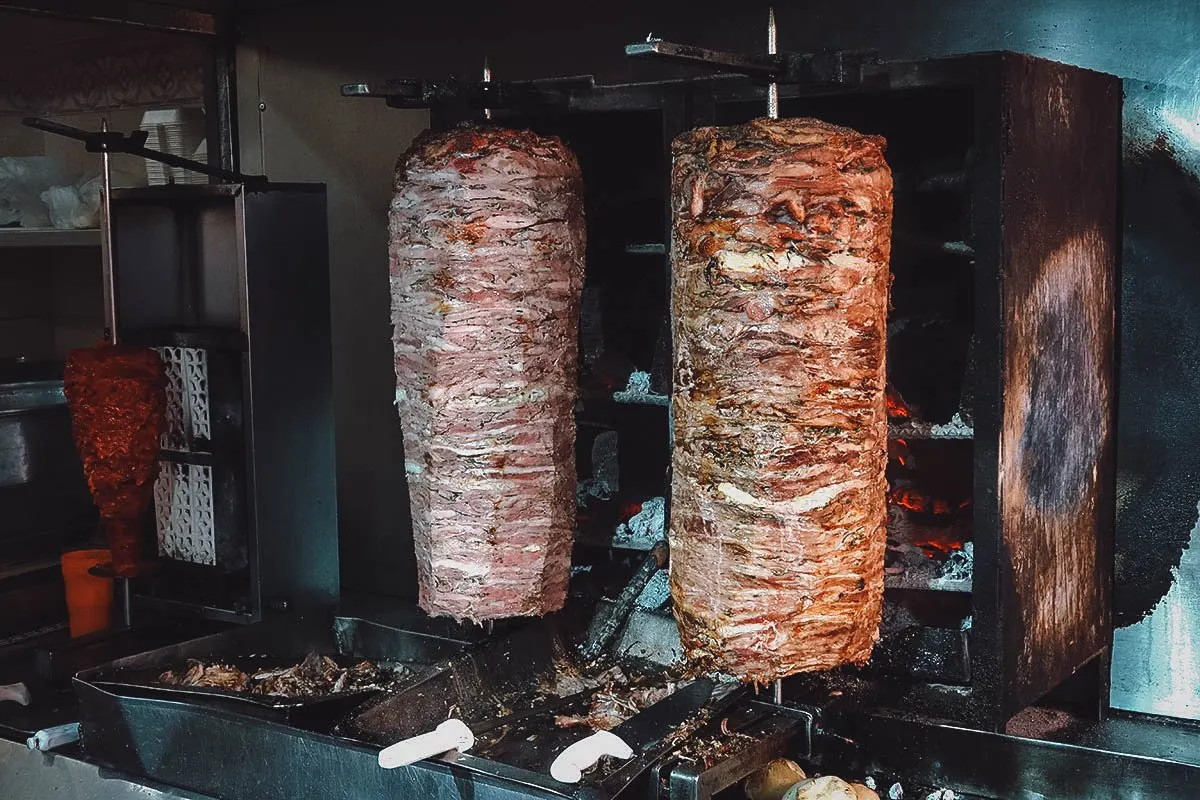
When you look at taqueria menus in Puebla, many will have terms like “taco arabe”, “taco de harina”, and “taco oriental”. They’re all made with arabe meat but the difference is in the bread they’re served in.
Taco arabe is served in pan arabe or pita bread. Taco de harina is wrapped in a flour tortilla while taco oriental is served in a corn tortilla. The picture below illustrates the difference between tacos arabes and tacos oriental. Because corn tortillas are typically palm-sized, tacos oriental are considerably smaller than tacos arabes and much lower in price.
We’ve tried all three tacos and for us, tacos arabes are the most delicious. In our opinion, the fluffiness and chewiness of pan arabe works best with this type of meat.
Speaking of tacos, be sure to check out our guide on the best tacos in Mexico City. It lists some of the best places in the capital to enjoy taco favorites like al pastor, suadero, cabeza, and guisado.
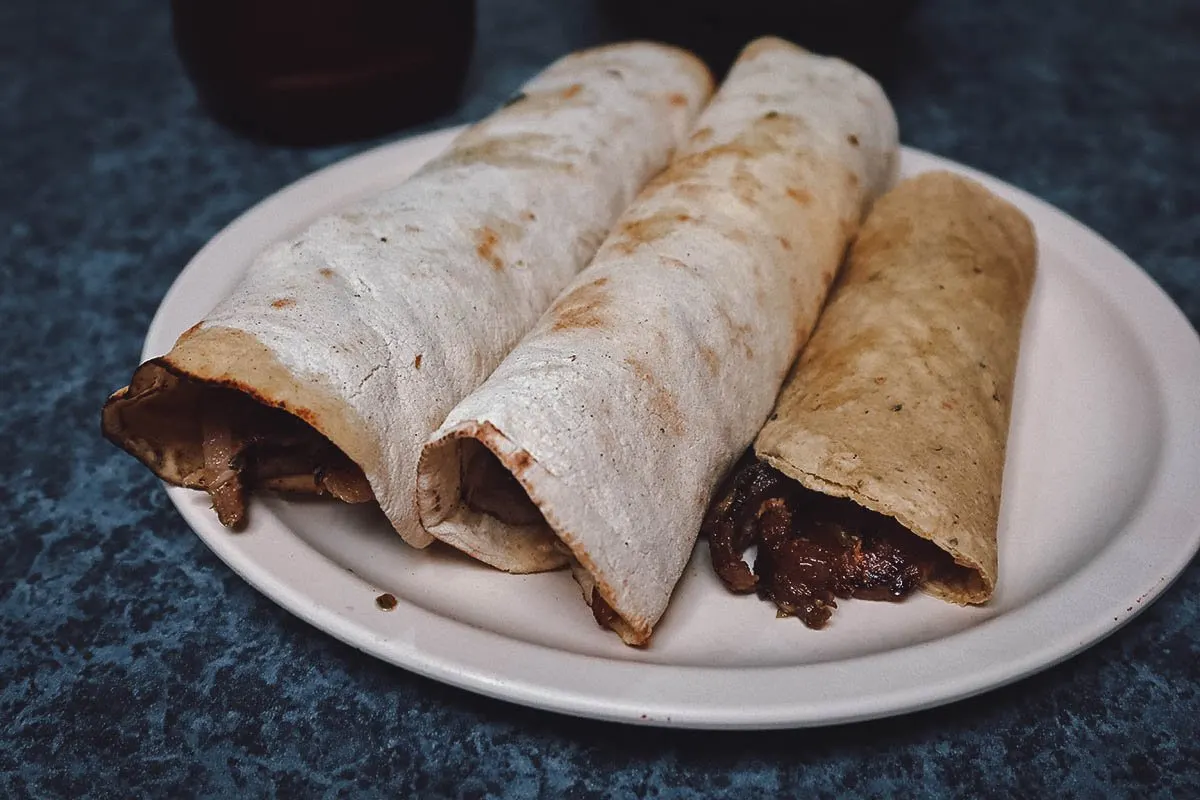
6. Chalupas
The chalupa is a tasty Mexican snack that originated in south-central Mexican states like Puebla, Hidalgo, Guerrero, and Oaxaca. It consists of a thin layer of deep-fried masa dough topped with different ingredients like shredded meat, lettuce, refried beans, onions, peppers, and salsa.
Chalupas can be made with different ingredients depending on where it’s from, but in Puebla, it typically consists of shallow-fried discs of masa topped with shredded chicken or pork, cheese, chopped onion, and either red or green salsa.
You can eat chalupas at many restaurants and street food stalls in Puebla. At some places, you’ll find them topped with mole poblano instead of the usual salsa.
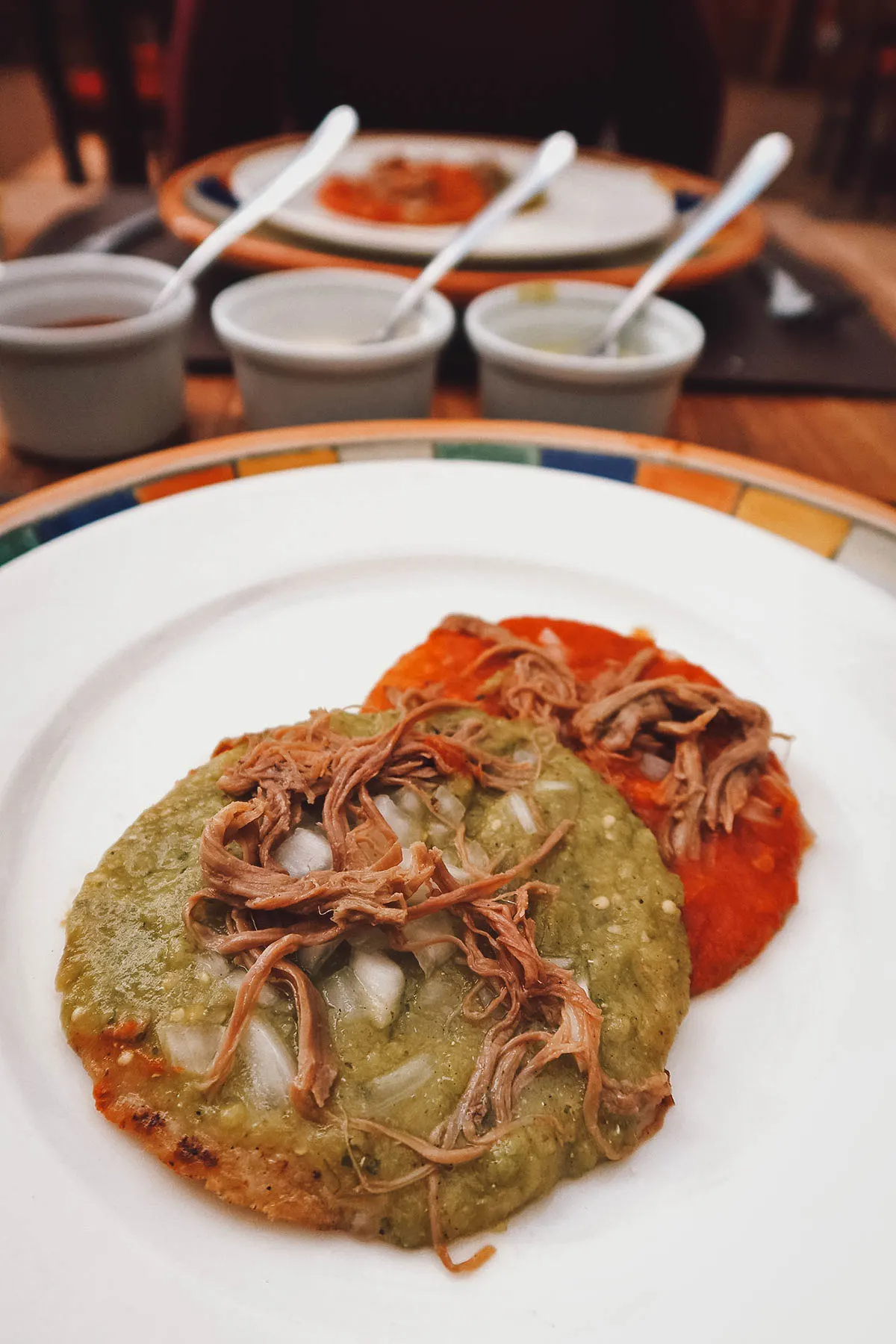
7. Cemitas
In Guadalajara, tortas ahogadas are among the most popular comfort foods. In Mexico City, it’s the taco. In Puebla, it’s cemitas.
Cemitas are basically Pueblan tortas (sandwiches) served on bread rolls covered in sesame seeds. Torta is the generic word for a Mexican sandwich while cemita de Puebla refers to a specific type of torta made with meat, slices of avocado, quesillo (Oaxacan cheese), onions, pápalo, and chipotle adobado. Cemitas made with milanesa – flattened breaded fillets of chicken, pork, or beef – are among the most popular.
Cemitas are arguably the most ubiquitous food in Puebla. We tried it at several places – both at restaurants and street food stalls – and we never met a cemita we didn’t like. They’re cheap and make for a tasty quick snack in Puebla.
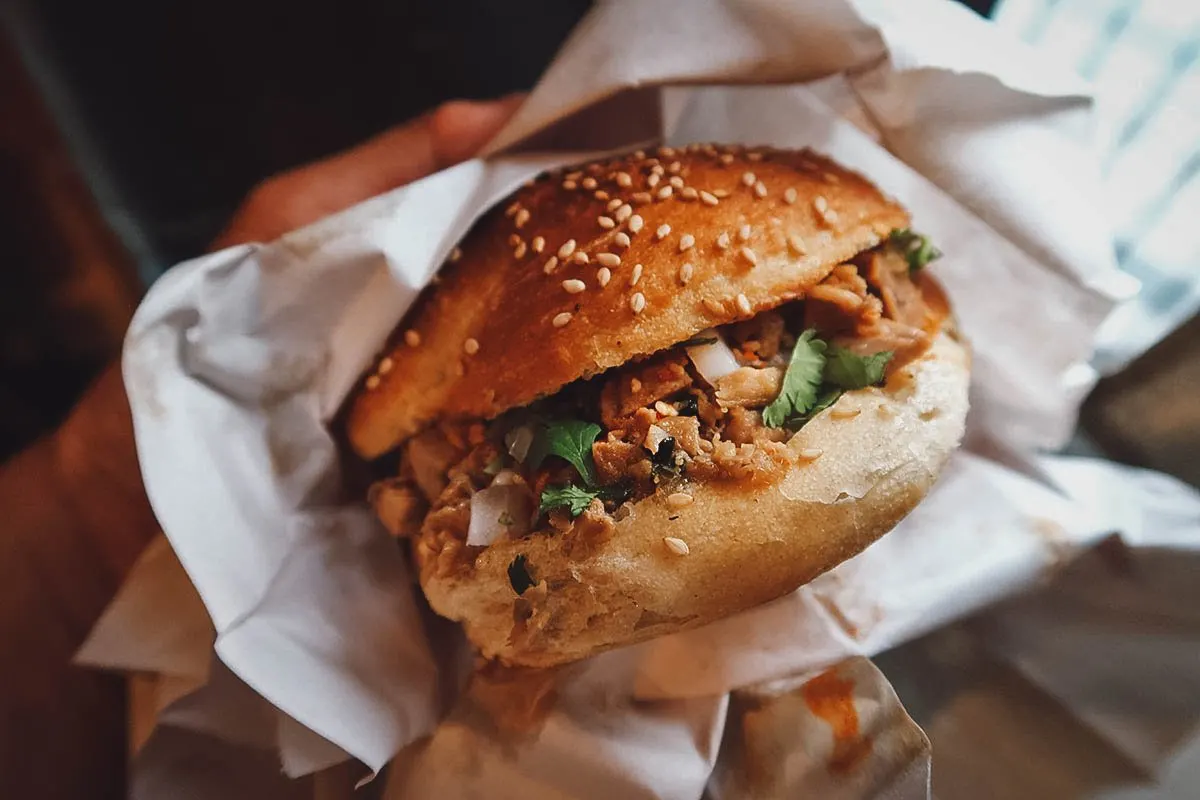
If you like sandwiches and have a big appetite, then the super cemita is more up your alley. Made with the same ingredients but on a much bigger bread roll, it’s basically the supersized version of a cemita.
Be sure to check out our Puebla restaurant guide to find out where you can enjoy this sexy beast of a Mexican sandwich.
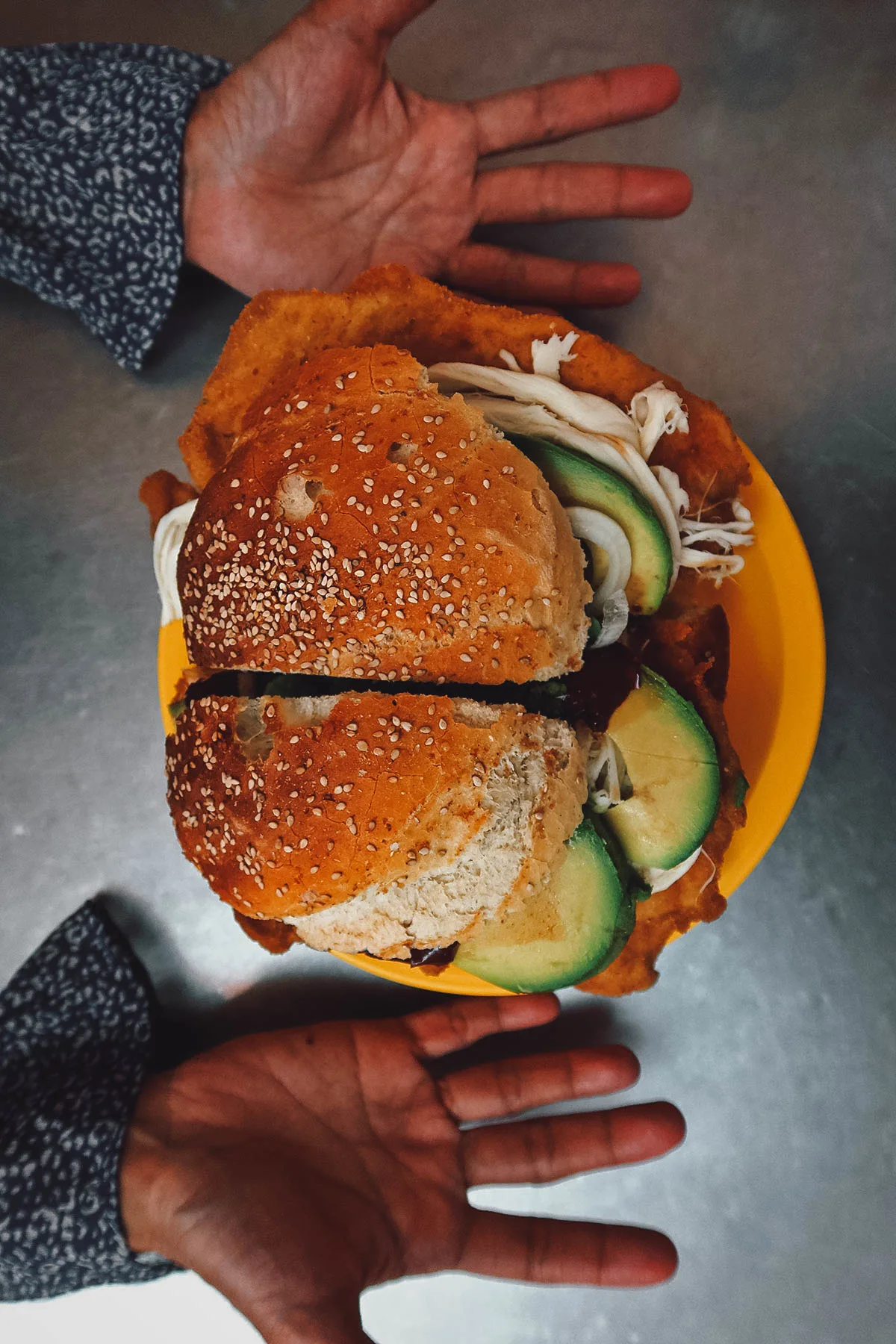
8. Pelonas
If cemitas sound appealing to you, then you definitely need to try pelonas as well. It’s another type of Poblano sandwich made with a specific set of ingredients – shredded beef, refried beans, lettuce, and salsa – served on a deep-fried bread roll.
Pelonas are absolutely delicious and may have been my single favorite dish in Puebla. The fillings are good but deep-frying the bread is what really makes this dish. It’s crunchy but very light and crumbles away when you take a bite. It’s so good.
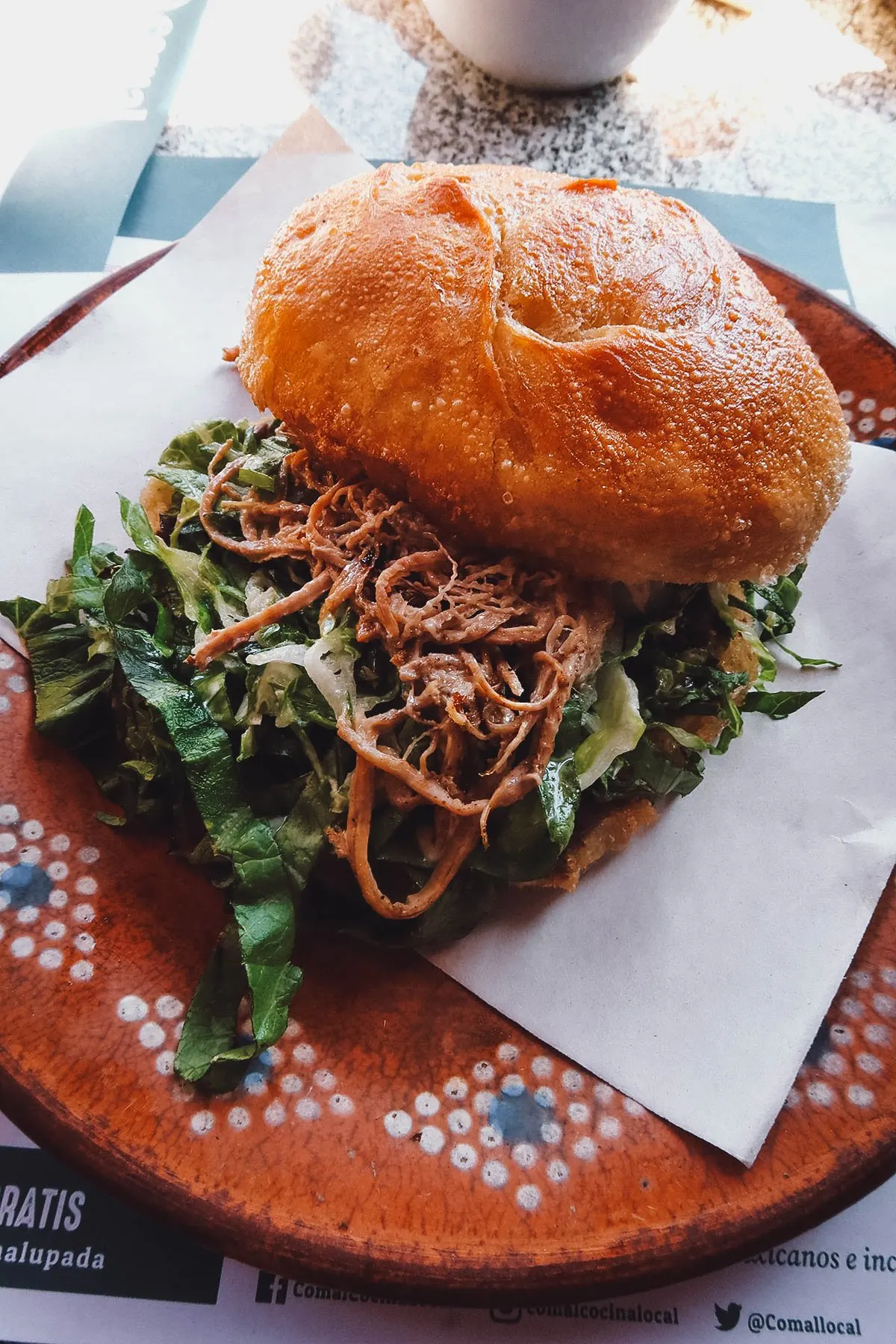
9. Chanclas
It may not seem like it but what you’re looking at below is another must-try Poblano sandwich. Called chanclas, they’re Puebla’s answer to Guadalajara’s tortas ahogadas.
Chanclas are similarly soppy sandwiches made with flour-dusted pambazo bread drenched in a spicy tomato-based sauce called guajillo sauce. Fillings typically consist of a mixture of ground beef, chorizo, avocado slices, onions, and lettuce.
Chanclas in English translates to “sandals” or “flip-flops”, perhaps in reference to the bread’s shape. Pambazo bread is so incredibly light that you almost forget you’re eating a sandwich.
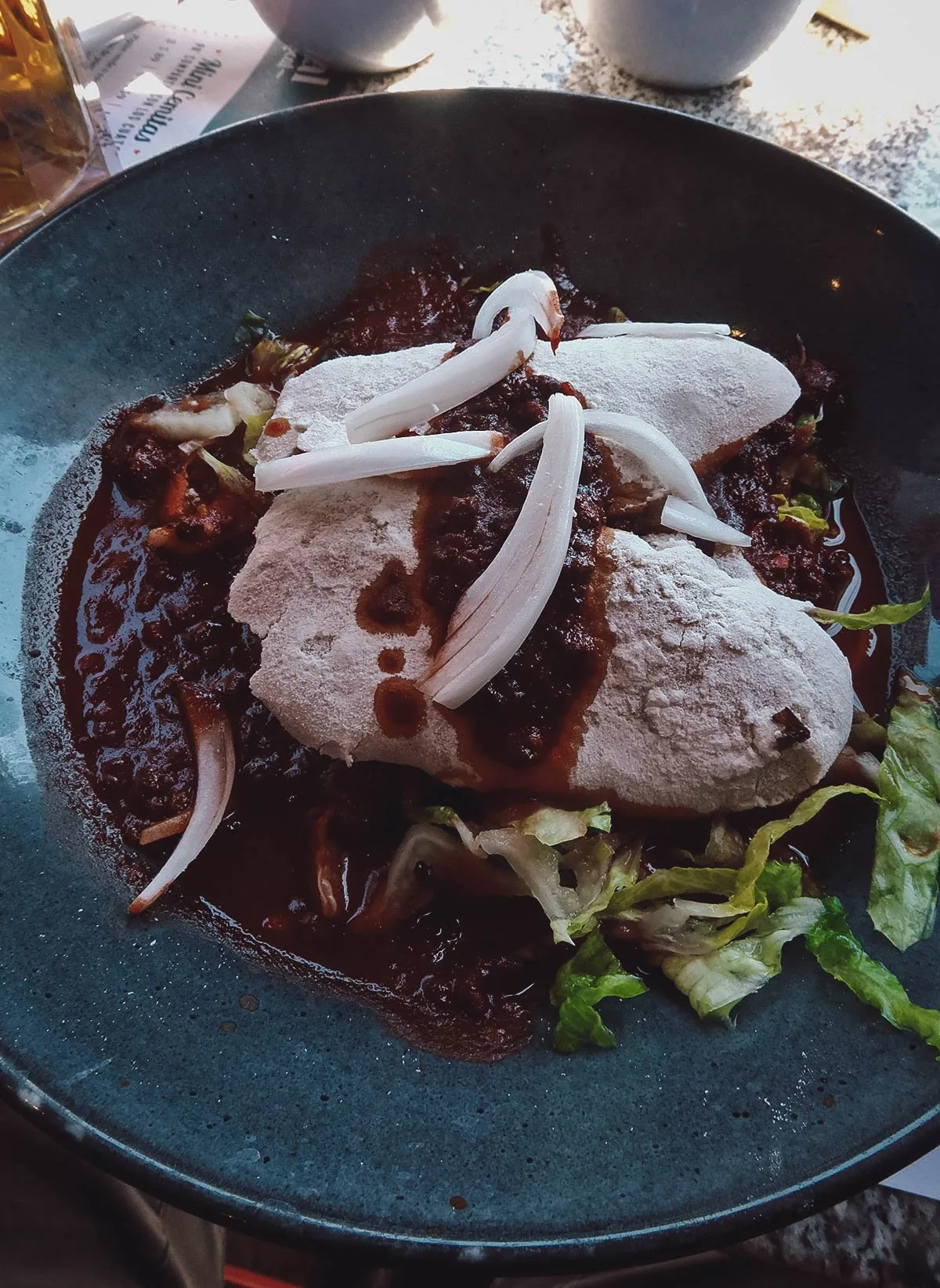
10. Molotes
Molotes are another popular street food dish in Puebla. They’re empanada-like antojitos (snacks) made with a mixture of corn masa and all-purpose flour stuffed with a variety of ingredients like chicken tinga (shredded chicken), Oaxacan cheese, mushrooms, and huitlacoche (corn smut). The fillings are sealed in a half-moon shape before being deep-fried to a crispy, golden brown.
Like cemitas, molotes are everywhere in Puebla. They’re similar in shape to empanadas but they’re typically much larger and with a thicker, harder shell. They’re topped with cream and one or two salsas (red and/or green) before serving.
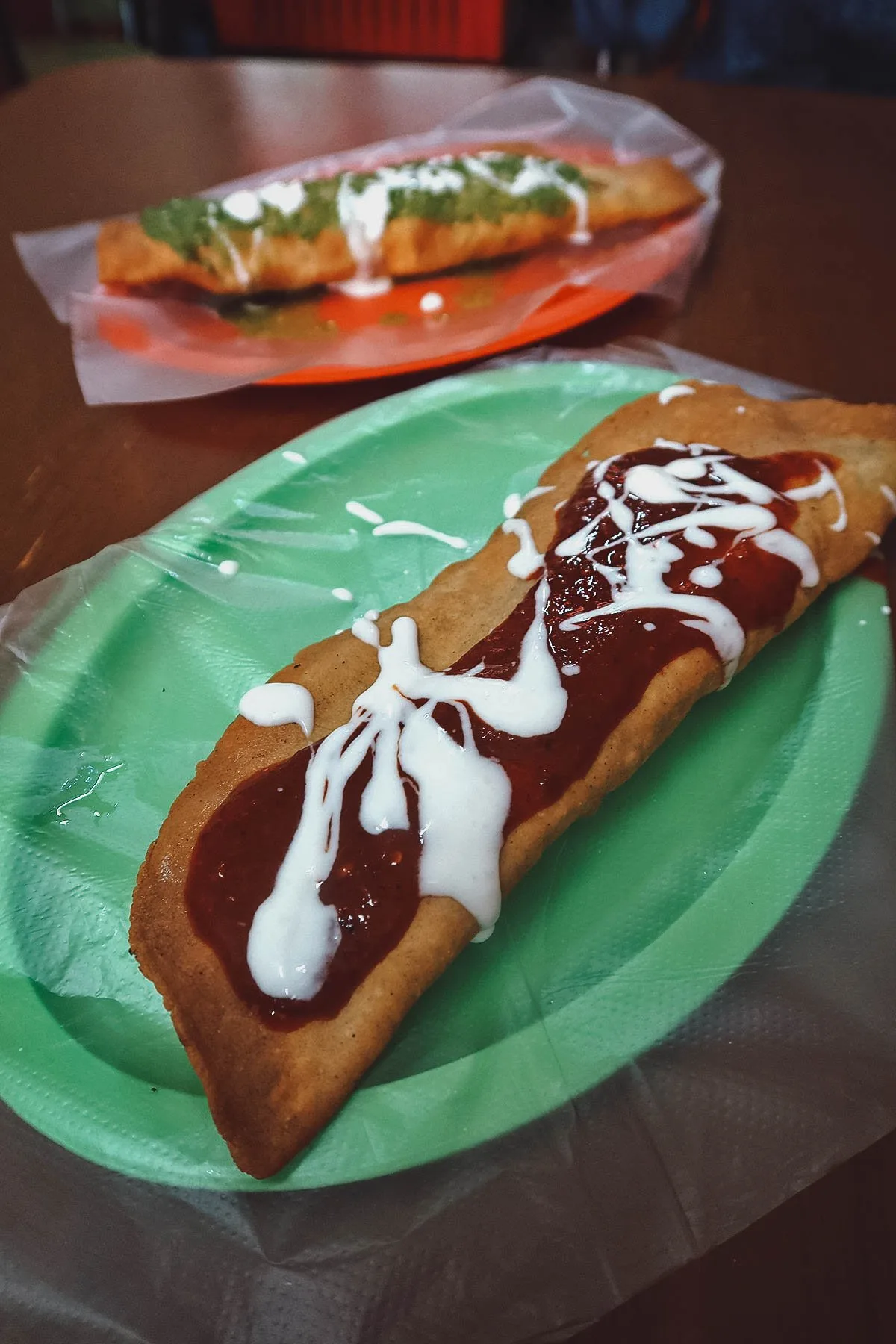
11. Dulces Típicos de Puebla
If you have a sweet tooth, then you’re going to love Puebla. It’s home to over 300 types of dulces típicos or traditional sweets.
Borne from the influx of foreign influences and ingredients, Puebla’s handmade artisanal sweets were created in convents during colonial times and were initially given as gifts to the convents’ benefactors. Today, they’re sold all throughout Puebla and make for the perfect souvenir food item.
One street with a particularly high concentration of sweets shops is Avenida 6 Oriente. There are so many candy shops along this street that it’s often referred to as “Calle de Los Dulces”.
There are too many sweets to list in this article but some of the most popular include camotes, borrachitos, tortitas de Santa Clara, and ate. Pictured below are camotes, a type of dulce made with sweet potatoes, sugar, and lemon or orange essence. They’re made in different colors and flavors and are known to be the most popular type of dulce in Puebla.
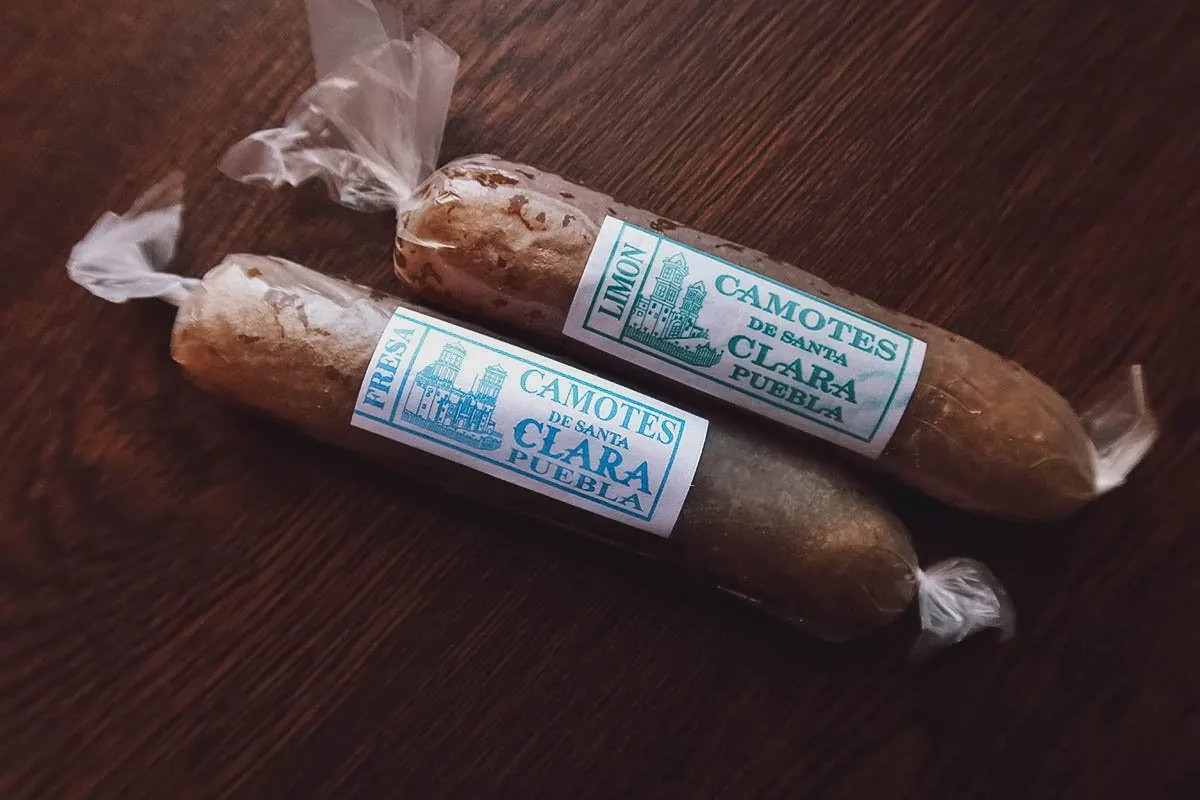
If you like candies spiked with alcohol, then you need to pick up a pack of borrachitos. Meaning “little drunks” in Spanish, borrachitos are poblano sweets made with cornstarch and sugar enhanced with some type of alcohol like tequila, rompope (Mexican eggnog), or cognac.
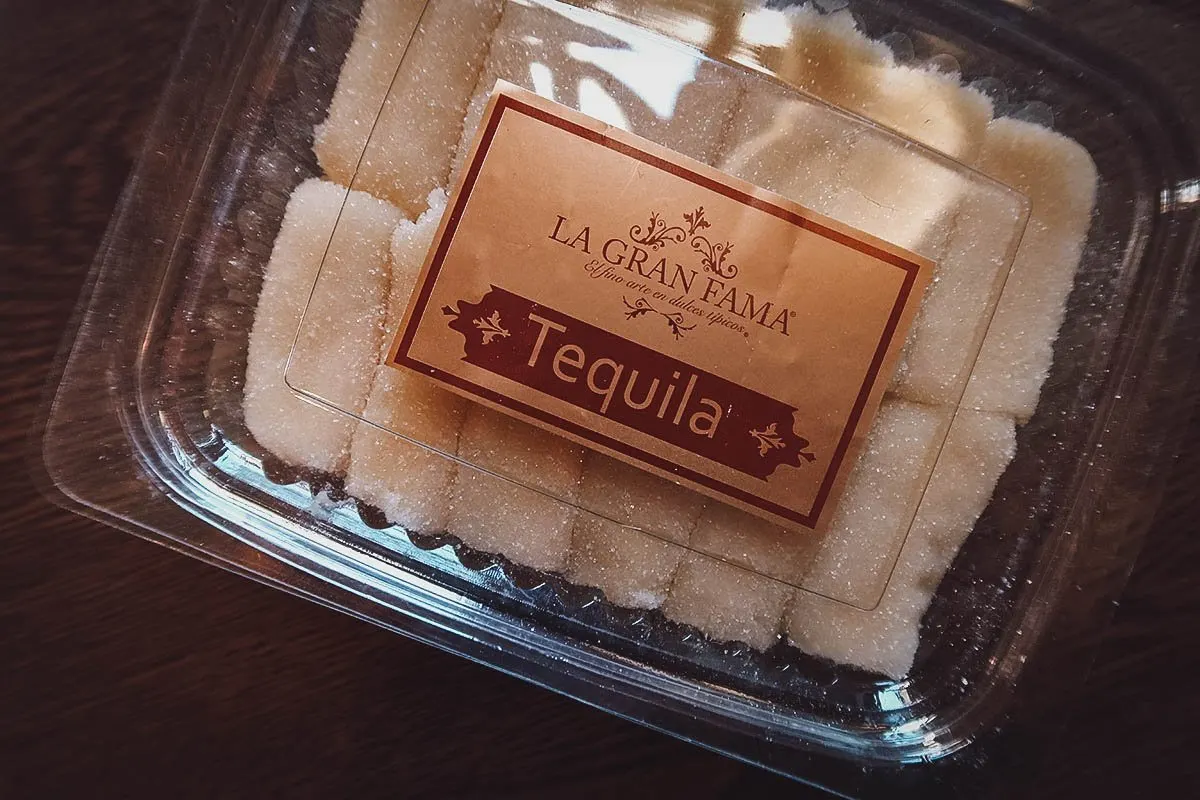
Tortitas de Santa Clara are cookie-shaped sweets made with pepitas, egg yolks, milk, flour, icing sugar, lard, and teqesquita (natural mineral salt). It gets its name from the convent where it was invented – Santa Clara.
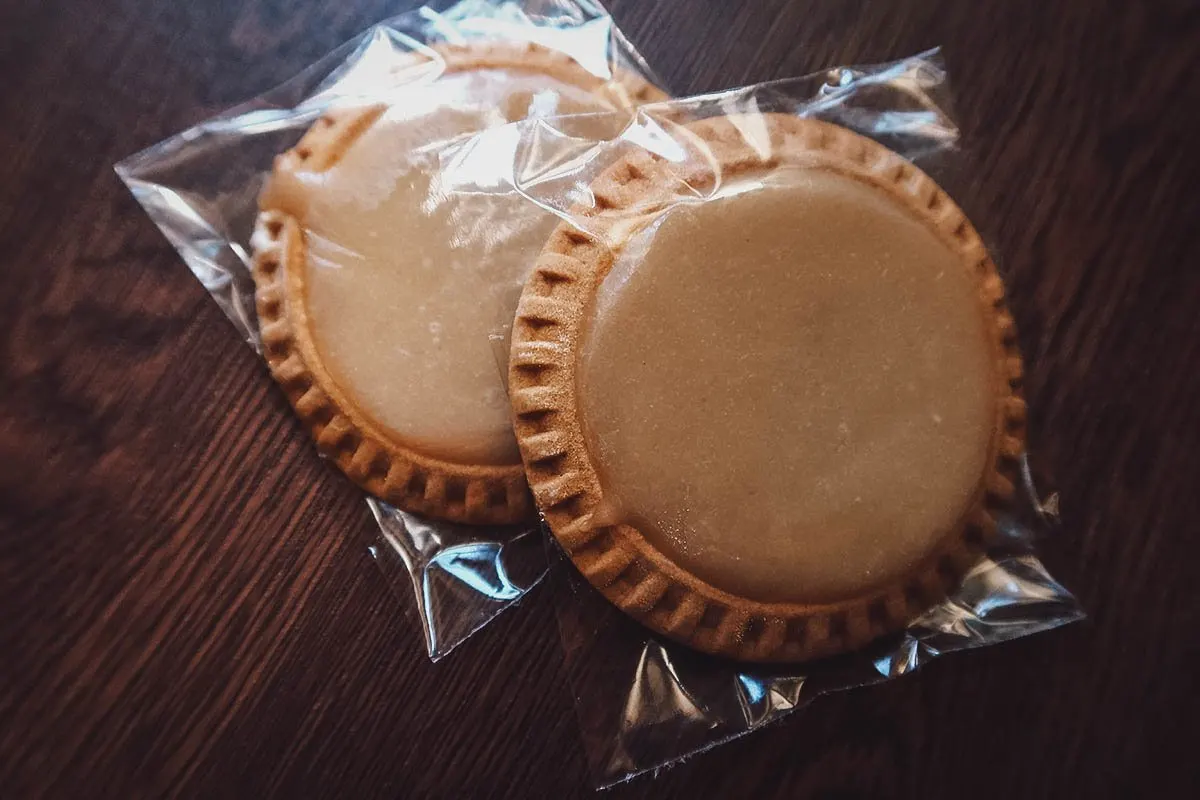
These sweets known as ate may not be as popular as the previous three, but they may have been my favorite. They’re made with pureed fruit pulp that’s cooked with sugar or piloncillo (unrefined whole cane sugar) until it thickens and hardens into a paste.
Also known as quince jam, ate used to be made only with quince but they can now be made with almost any type of fruit, one of the most popular being guava. Pictured below are blocks of guava ate, the one on the left enhanced with chili.
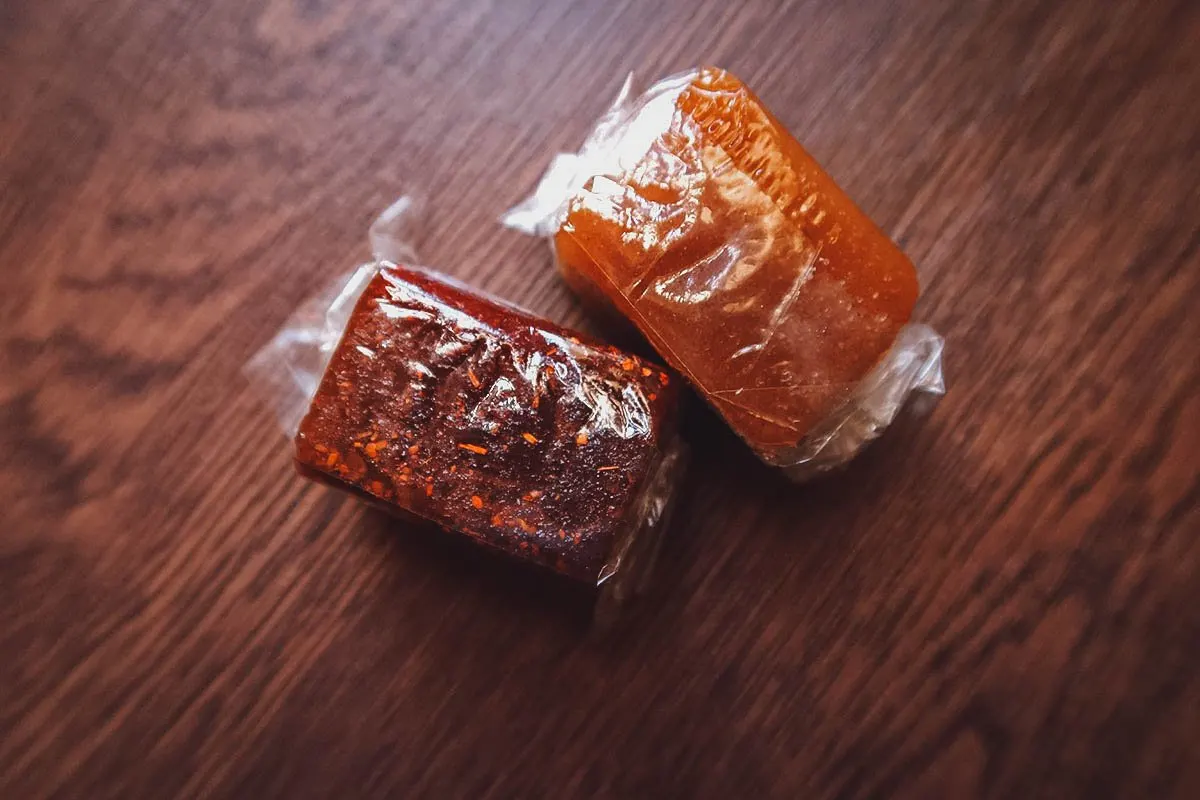
12. Pasita
All the dishes mentioned in this list are native to Puebla. This last entry, a raisin-flavored liqueur called “pasita”, isn’t just native to Puebla, it’s native to one Pueblan bar of the same name.
Pasita is the trademark drink of La Pasita, a small cantina or Mexican bar located at one end of Callejón de Los Sapos. It consists of a house-made raisin liquor served with a toothpick-skewered raisin and a cube of goat cheese.
Served in a slender shot glass called a caballito (“slender horse”), this fruity amber-hued liqueur has been the signature drink of La Pasita for over fifty years.
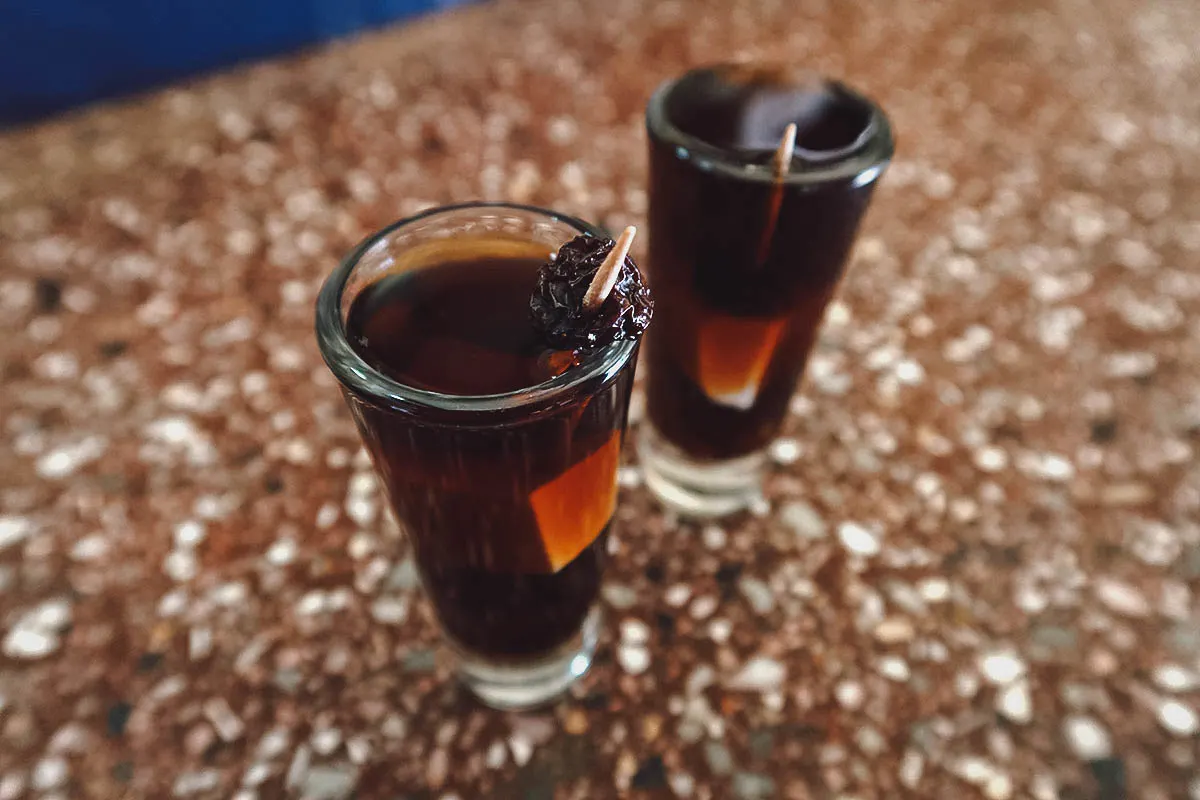
PUEBLAN FOOD TOURS
Traveleating on your own is always fun, but if you have limited time in Puebla, then you may want to go on a food tour. Not only will a local guide you to the city’s best restaurants, markets, and food stalls, but they’ll be able to explain all the dishes to you in more detail. Check out Get Your Guide for a list of food tours in Puebla.
PUEBLAN COOKING CLASSES
Going on a food tour is a great way to sample the best Pueblan food in a short amount of time. But if you’re staying long enough, then you may want to take a cooking class. Simply put, there’s no better way to learn about local dishes than by making them yourself. It’s like looking under the cuisine’s hood. Check out Cookly for a list of cooking classes in Puebla.
FINAL THOUGHTS ON PUEBLAN MEXICAN CUISINE
Of all the cities we’ve visited so far in Mexico, Puebla is one of our favorites, and a lot of that has to do with the food. Twelve dishes is a good number but it’s only just the beginning. This delicious state in central Mexico has so much more to offer.
We haven’t tried them yet but I’ve read about other moles and sauces like mole de chilayo, mole verde de Zacapala, and adobo. Adobo is of particular interest to us because it’s the national dish of the Philippines, where we’re originally from.
The word adobo stems from the Spanish word adobar, meaning”to marinate”. There are many differences between the two versions but vinegar is a key ingredient in both. Was our adobo a product of Mexican influence, thanks to the Manila-Acapulco Galleon Trade Route? It’s possible. In any case, that’s a discussion better left for another article.
I hope you enjoyed this list of must-try dishes in Puebla. If you’re a local and have obscure food recommendations for us, then we’d love to hear from you. ¡Muchas gracias!
Disclosure
Some of the links in this Pueblan food guide are affiliate links, meaning we’ll earn a small commission if you make a purchase at no added cost to you. As always, we only recommend products and services that we use ourselves and firmly believe in. We really appreciate your support as this helps us make more of these free travel guides. Muchas gracias!

